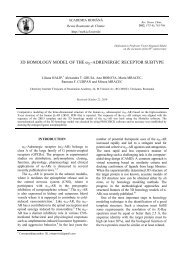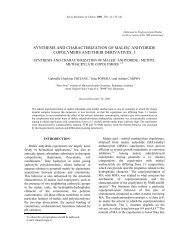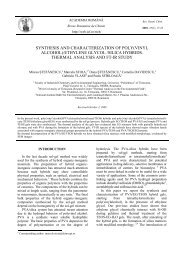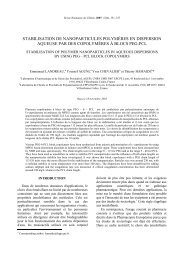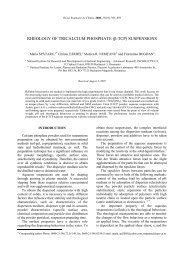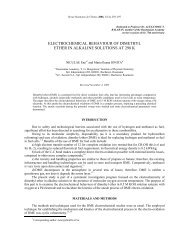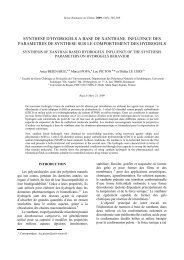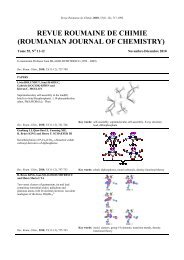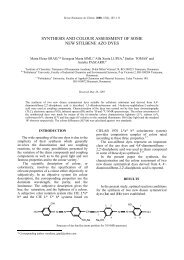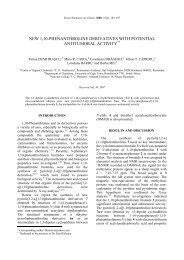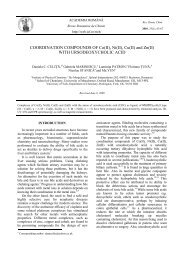HPLC METHOD FOR QUANTIFICATION OF NIZATIDINE AND ITS N ...
HPLC METHOD FOR QUANTIFICATION OF NIZATIDINE AND ITS N ...
HPLC METHOD FOR QUANTIFICATION OF NIZATIDINE AND ITS N ...
Create successful ePaper yourself
Turn your PDF publications into a flip-book with our unique Google optimized e-Paper software.
Revue Roumaine de Chimie, 2007, 52(3), 261–266<strong>HPLC</strong> <strong>METHOD</strong> <strong>FOR</strong> <strong>QUANTIFICATION</strong> <strong>OF</strong> <strong>NIZATIDINE</strong><strong>AND</strong> <strong>ITS</strong> N-DESMETHYLMETABOLITE IN HUMAN PLASMASilvia IMRE a* , Laurian VLASE b and Sorin E. LEUCUŢA ba Faculty of Pharmacy, University of Medicine and Pharmacy, Gheorghe Marinescu 38,Targu-Mures, RO-540139, Roumania, E-mail: silsta@yahoo.comb Faculty of Pharmacy, University of Medicine and Pharmacy “Iuliu Hatieganu”, Emil Isac 13,Cluj-Napoca, RO-400023, RoumaniaReceived August 3, 2006A simple and fast <strong>HPLC</strong> method for quantification of nizatidine and N-desmethylnizatidine in human plasma has beendeveloped and validated. After protein precipitation from plasma sample with perchloric acid, clear supernatant wasinjected at 42 ºC into a C18 column. The elution was made in 4 minutes at 1 ml min -1 in gradient mode, with an UVdetection at 314 nm, using a mixture of aqueous potassium dihydrogenophosphate 40 mM pH 2.3, methanol andacetonitrile. The linearity domains were established between 80 to 3200 ng ml -1 for nizatidine and between 12 and484 ng ml -1 for N-desmethylnizatidine, respectively. Accuracy (bias%) and precision (CV%) were less than 5.3% forintra-day assay and 8.1%, for inter-day assay, and less than 11.4% and 17.2%, respectively, at the limits ofquantification. The recovery ranged between 93.9 and 104.2%. The analytes were proved to be stable in plasma over aperiod of 6 months below -20 ºC.INTRODUCTION ∗Nizatidine, N-[2-[[[2-[(dimethylamino)methyl]-4-thiazolyl]methyl]thio]ethyl]-N'-methyl-2-nitro-1,1-ethenediamine, is a competitive reversible H 2 -receptor antagonist approved in adults for thetreatment of acid-related gastrointestinal disorders,including duodenal and gastric ulcers, erosive andulcerative esophagitis, and gastroesophageal refluxdisease. 1,2The literature of the analytical chemistry ofnizatidine in human plasma is extensive, withmethods based on <strong>HPLC</strong> with ultraviolet 3-5 , MS 6-8 orelectrochemical detection. 9,10 The sample preparationapproach was mainly liquid-liquid extraction 11,13 , butsolid-phase extraction was also used. 6,7,12In a single-dose pharmacokinetic/ bioequivalence(PK/BE) study of a medicinal product, theextrapolated area of the curve which describesplasma concentration of the drug and metabolitesversus time after administration must not begreater than 20% of total calculated area. Toachieve this requirement a quantifiable concentrationmust be obtained after five half-life times and thesensitivity of the applied analytical method playsan important role. In the mean time, abioequivalence study involves analysis of hundredof samples and the development of a suitablechromatographic method must take into accountnot only a sensitive procedure, but also a fast one.Taking into account these facts, the primary aimof the study was to develop a fast <strong>HPLC</strong> methodwith enough sensitivity to quantify simultaneouslynizatidine and N-desmethylnizatidine in humanplasma by applying protein precipitation after oraladministration of 300 mg nizatidine. None of thestudied articles applied protein precipitation, asimple and low cost plasma sample preparation.The developed and validated method wassuccessfully applied for bioequivalence investigationof two medicinal products containing nizatidine bymonitoring the signal of both parent drug and itsN-desmethylmetabolite.RESULTS <strong>AND</strong> DISCUSSIONThe endogenous compounds or the usedanticoagulant did not interfere at the retention∗ Corresponding author.
Nizatidine in human plasma 265Mettler Toledo AB 54-S balance from Mettler Toledo,Greifenseee, Switzerland) in 10 ml methanol. Working solutionswere then obtained by diluting specific volumes of stocksolutions with water and used to spike 0.5 ml of plasma blank,providing finally seven plasma standards with theconcentrations ranged between 80 and 3200 ng ml -1 nizatidineand 12-484 ng ml -1 N-desmethylnizatidine. Accuracy andprecision were verified at four levels of concentration,including lower limits of quantification: 80, 160, 1600 and2400 ng ml -1 for nizatidine, and 12, 24, 242 and 363 ng ml -1for metabolite. Duplicated quality control samples, namelyQCA, QCB and QCC, of 160, 800 and 2400 ng ml -1 nizatidineand 24, 121 and 363 ng ml -1 N-desmethylnizatidine, were usedduring clinical samples analysis, in order to ensure that themethod continues to perform adequately.Sample preparationAt 0.5 ml plasma sample, 0.08 ml water (or total workingsolutions of analytes) were added and mixed with 0.12 mlperchloric acid 14% for five seconds via a vortex mixer(Genie 2, Scientific Industries Inc., USA). After 15 minutes ofrest, a centrifugation for eight minutes at 5000 rpm was made,using a Sigma 204 centrifuge (Germany). The supernatant wastransferred in an autosampler vial and 75 µl were injected intothe <strong>HPLC</strong> system.Chromatographic system and conditionsThe <strong>HPLC</strong> system was an 1100 series model (AgilentTechnologies) consisted of a binary pump, an in line degasser,an autosampler, a column thermostat and an UV detector. Datawere collected and computed by ChemStation software (ver.A.09.03). The detector was operated at 314 nm.Chromatographic separation was performed in 4.1 minutes at42 °C with a Zorbax SB-C18 100 x 3 mm, 3.5 µm (AgilentTechnologies) column, protected by an on-line filter (2 µm).The elution was made in gradient mode at 1 ml min -1 , with apre-run equilibrating time of 1 minute: 0-2 minutes 100% A(4% methanol and 96% KH 2 PO 4 40 mM pH 2.3 with H 3 PO 485%); between 2-2.01 minutes solvent A decreases from100% to 35% and B (acetonitrile) increases from 0% to 65%;2.01-2.4 minutes 35% A and 65% B; 2.4-2.41 minutes Aincreases from 35% to 100%; 2.41-4.1 minutes 100% A. Themobile phase was degassed, before elution, for 10 minutes inan Elma Transsonic 700/H (Singen, Germany) ultrasonic bath.Method validationAs a first step of method validation 14,15 , specificity wasverified using six different plasma blanks obtained fromhealthy human volunteers who did not take before nizatidineand any other medication. The anticoagulant (Li-heparin)interference was also verified during this stage.The linearity of the peak area against standardconcentration was verified between 80-3200 ng ml -1 nizatidineand 12-484 ng ml -1 N-desmethylnizatidine in three differentdays, by applying least-squares linear regression. Distributionof the residuals (% difference of the back-calculated concentrationfrom the nominal concentration) was investigated. Thecalibration model was accepted, if the residuals were within±20% at the lower limit of quantification and within ±15% atall other calibration levels and at least 2/3 of the standardsmeet this criterion.The limits of quantification were established as the lowestcalibration standard with an accuracy and precision less than 20%.The intra- and inter-day precision (expressed as coefficientof variation %, CV%) and accuracy (relative difference %between found and theoretical concentration, bias%) of theassay procedure were determined by the analysis in the sameday of three samples at each of three levels of concentration inthe considered concentration range and one sample of each inthree different days, respectively. The recoveries at each ofpreviously levels of concentration were measured bycomparing the response of the treated plasma standards withthe response of standards in water with the same concentrationin nizatidine and N-desmethylnizatidine as the final extractfrom plasma standards.Aliquots of plasma samples containing 347 ng ml -1 nizatidineand 67.2 ng ml -1 N-desmethylnizatidine were frozen for sixmonths below -20 ºC and with four occasions during thisperiod, each of three samples were analyzed.Clinical application and in-study validationThe validated method was applied in a bioequivalencestudy of two dosage forms containing 300 mg nizatidine. Thecollecting times were 0, 0.5, 1, 1.5, 2, 2.5, 3, 4, 6, 8, 10, 12 hoursafter oral administration of 300 mg nizatidine. The accuracyand precision of the validated method was monitored to ensurethat it continued to perform satisfactorily during analysis ofvolunteer samples. To achieve this objective, a number of QCsamples prepared in duplicate at three levels of concentrationwere analyzed in each assay run and reported at the calibrationcurve of the run. The runs were validated if four out of six QCsamples were within ±15% of their nominal concentration.Two but not all QC samples at the same concentration couldbe outside this range.REFERENCES1. A. Thompson, P. Kirdeikis, F. Jamali, M. Tavernini, L. Zuk,B. Marriage, I. Simpson and V. Mahachai, J. Gastroenterol.Hepatol., 1995, 10, 546-554.2. S. Xue, P.O. Katz, P. Banerjee, R. Tutuian and D. O.Castell, Aliment. Pharmacol. Ther., 2001, 15, 1351-1356.3. M. P. Knadler, R.F. Bergstrom, J. T. Callaghan and A. Rubin,Drug Metab. Dispos., 1986, 14, 175-182.4. A. Tracqui, P. Kintz and P. Mangin, J. Chromatogr. B:Biomed. Sci. Appl., 1990, 529, 369-376.5. Y. Gaillard and G. Pépin, J. Chromatogr. A, 1997, 763,149-163.6. R. A. Blum, A. J. Braverman, P. Rice and F. K. Johnson,J. Clin. Pharmacol., 2003, 43, 74-83.7. S. M. Abdel-Rahman, F. K. Johnson, G. Gautheir-Dubois,I. E. Weston and G. L. Kearns, J. Clin. Pharmacol., 2003,43, 148-153.8. S. M. Abdel-Rahman, F. K. Johnson, J. D. Connor,A. Staiano, C. Dupont, V. Tolia, H. Winter, G. Gauthier-Dubois and G. L. Kearns, J. Pediatr. Gastroenterol. Nutr.,2004, 38, 442-451.
266 Silvia Imre et al.9. K. Nikolic, M. Bogavac and B. Stankovic, J. Pharm.Biomed. Anal., 1995, 13, 683-685.10. A. A. Al-Majed, F. Belal, A. M. Al-Obaid and A. H. Dawoud,J. Pharm. Biomed. Anal., 1999, 21, 319-326.11. A. Tracqui, P. Kintz and P. Mangin, J. Forensic Sci.,1995, 40, 254-262.12. G. Carlucci, J. Chromatogr. B Biomed. Sci. Appl., 1990,525, 490-494.13. S. Takedomi, H. Matsuo, K. Yamano, T. Iga and Y. Sawada,Drug Metab. Dispos., 1998, 26, 318-323.14. U.S. Department of Health and Human Services, Food andDrug Administration, Guidance for Industry – BioanalyticalMethod Validation, 2001, http://www.fda.gov/cvm.15. The European Agency for the Evaluation of MedicinalProducts, Note for Guidance on the Investigation ofBioavailability and Bioequivalence, 2001,http://www.eudra.org/emea.html.



